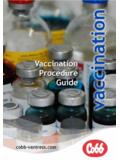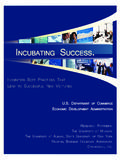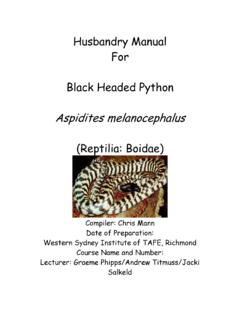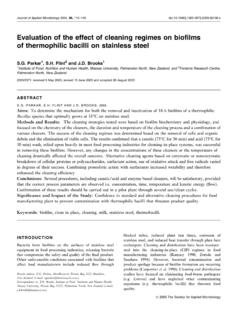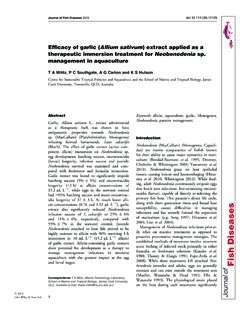Transcription of Hatchery Management Guide - Cobb Vantress …
1 Hatchery Hatchery Management Guide COBB Hatchery Management Guide Introduction Many changes have taken place in hatcheries in recent years, such as the introduction of computer monitoring and control of the machines, and automation of many day-to-day Hatchery operations. Additionally, there is increasing awareness of the role of the Hatchery in disease control. A sound understanding of the principles involved in incubating eggs and hatching chicks is vital to coping with these changes. This Guide is designed to explain these principles as related to broiler breeding stock and to highlight the main aspects of Hatchery Management from egg production to chick delivery. We provide this Guide as a supplement to your Hatchery Management skills so that you can apply your knowledge and judgment to obtain the best results. This publication links with the Cobb Breeder and Broiler Management Guides to provide technical advice from supply of breeding stock to delivery of broilers for processing.
2 Our recommendations are based on current scientific knowledge and practical experience around the world. You must be aware of local legislation, which may influence the Management practice that you choose to adopt. Revised 2008. Chick Embryo Infertile No development. Day 1. Appearance of 1 Day 2 2. Tissue development tissue development. very visible. Appearance of blood vessels. Day 7 7 Day 8 8 Day 9 9. Comb growth begins. Feather tracts seen. Embryo starts to look Egg tooth begins to Upper and lower bird-like. appear. beak equal in length. Mouth opening appears. Day 14. Embryo turns 14 Day 15 15. Gut is drawn into Day 16 16. Feathers cover head towards abdominal cavity. complete body. large end of egg. Albumen nearly gone. Development Day 3. Heart beats. 3 Day 4. Eye pigmented. 4 Day 5. Appearance of 5 Day 6 6. Appearance of beak. Blood vessels elbows and knees. Voluntary movements very visible. begin. Day 10 10 Day 11.
3 Egg tooth prominent. Comb serrated. 11 Day 12 12. Toes fully formed. Day 13 13. Appearance of Toe nails. Tail feathers apparent. First few visible scales. feathers. Body covered lightly with feathers. Day 17 17. Amniotic fluid Day 18 18. Growth of embryo Day 19 19. Yolk sac draws into Day 20 20. Yolk sac drawn decreases. nearly complete. body cavity. completely into body. Head is between Yolk sac is still on Amniotic fluid gone. Embryo becomes legs. outside of embryo. Embryo occupies a chick (breathing Head is under the most of space within in air cell). right wing. egg (not in the air Internal and external cell). pip. COBB Hatchery Management Guide Contents Page 1. Hatchability - The Measure of success 1. 2. Hatch of Fertile 2. 3. Hatching Egg Management 3-7. Key Points on Egg Storage 5. Optimum Egg Storage Conditions 6. Effects of Egg Storage 7. Setting Eggs 7. Setting Time 7. 4. Setter Operation 8-12. Ventilation 8.
4 Temperature Control 10. Humidity 11. Turning 12. 5. Egg Transfer 13. 6. Factors Influencing Chick Size 14. 7. Operation of Hatchers 14. Ventilation and Humidity 14. Temperature 14. 8. Chick Pull and Processing 15-18. Feather Sexing Broiler Chicks 16. The Hatch Window 17. 9. Hatchery Waste Disposal 19. 10. Chick Transport 19. 11. Altitude 20. Oxygen Availability 20. Water Loss 20. 12. Maintenance 21. Preventative Maintenance 21. 13. Hatchery Automation 22. COBB. COBB Hatchery Management Guide Contents Page 14. Hatchery Design 23-26. Structure 23. Installation of Hatcher and Incubation Plenums 24. Location 26. 15. Hatchery Sanitation 27-28. 16. Records 29. 17. Troubleshooting 30-35. Major Causes of Eggs Failing to Hatch 30. Stages of Embryonic Development 31. 18. Metric Conversions 36. List of Diagrams Controlling Factors 1 Hatch of Fertile 2. Hatching Egg Variations 4. Egg Temperature Flow Chart 5. Optimum Temperature Range for Egg Storage 6.
5 Hatchery Ventilation - the Correct set-up 9. Heat Production of Incubating Eggs 9. Relationship Between Average Hatch Time, 10. Hatchability and Temperature Optimum Weight Loss of Eggs During Incubation 11 Related Chick Weight 14. Feather Sexing Broiler Chicks 16. The Hatch Window 18. Exhaust Plenum 26. Properties of Disinfectant Chemicals Used in Hatcheries 28. Candle and Candle Breakouts 30. Psychrometric Chart 35. Hatchery Residue Breakout 37. COBB. COBB Hatchery Management Guide 1. Hatchability - the measure of success The measure of success of any Hatchery is the number of first-quality chicks produced. This number expressed as a percentage of all eggs set for incubation is normally termed hatchability. Hatchability is influenced by many factors. Some of these are the responsibility of the breeding farm and others are the responsibility of the Hatchery . Mating activity is a good example of a factor entirely influenced on the farm.
6 The Hatchery cannot alter it, although many other factors can be influenced by both the farm and the Hatchery . Controlling factors Farm Hatchery Breeder Nutrition Sanitation Disease Egg Storage Mating Activity Egg Damage Egg Damage Incubation - Management of setters and hatchers. Correct Male and Female BW. Egg Sanitation Chick Handling Egg storage Thus, the breeder farm has a major influence on results at the Hatchery and it is essential for the farm and Hatchery to work closely together. COBB 1. COBB Hatchery Management Guide 2. Hatch of fertile Because hatcheries have no influence over fertility, it is important to consider hatch of fertile in addition to hatchability. The hatch of fertile percent is a measurement of the efficiency of the Hatchery machinery. Hatch of fertile takes into account the flock fertility as well as hatchability; it is percent hatch divided by percent fertile times 100. Example: ( Hatch 96% Fertile) * 100 = 90% Hatch of Fertile The following example clearly shows the value in calculating Hatch of Fertile.
7 Hatchery % Hatch % Fertile % Hatch of Fertile A 86 97 B 82 91 C 84 94 Even though Hatchery B has the lowest % Hatch, it has the highest % Hatch of Fertile. This is because % Hatch was limited by fertility and not by the hatcheries ability to effectively hatch eggs; therefore, Hatchery B is clearly performing the best, provided chick quality is equal. At peak production, flocks should be achieving at least fertility and hatch of fertile. Fertility and hatch percent standards are set according to the age of the breeders. Breeder age Hatch of fertile (weeks) (%). 25 to 33 > 34 to 50 > 51 to 68 > The benefits of recording Hatch of Fertile are as follows: 1. Separates fertility and Hatchery problems 2. Allows you to focus on the problem 3. Expedites troubleshooting 2 COBB. COBB Hatchery Management Guide 3. Hatching egg Management Optimum hatchability and chick quality can only be achieved when the egg is held under optimum conditions between laying and setting in the incubator.
8 Remember that a fertile egg contains many living cells. Once the egg is laid, its hatching potential can at best be maintained, not improved. If mishandled, hatching potential will quickly deteriorate. 1. Use of floor eggs depresses hatchability. They should be collected and packed separately from nest eggs, and clearly identified. If they are to be incubated, they should be treated separately. 2. Prevent hair-line cracks by handling eggs carefully at all times. 3. Place hatching eggs carefully into the setter tray or transport tray, small (pointed) end downward. 4. Take care with egg grading. During the early production period check the weight of borderlined sized eggs to select hatching eggs. 5. Store the eggs in a separate room in which the temperature and humidity are controlled. 6. Keep the farm egg handling room clean and tidy. Maintain good vermin control in your egg room. Refuse to accept dirty egg containers and buggies from the Hatchery , and take care of them while on your premises.
9 Good egg COBB 3. COBB Hatchery Management Guide Remove and discard eggs unsuitable for hatching. These are: Dirty Cracked Small (According to Hatchery Policy). Very large or double yolk Poor shells - but any shell color should be acceptable for hatching Grossly mis-shapen Blood stained Cracked Dirty Elongated Rounded Toe punched Wrinkled Small and double 4 COBB. COBB Hatchery Management Guide Key points on egg storage Eggs should be collected from the farms and transported to the Hatchery at least twice a week. There are three storage areas: farm egg room, transport, and Hatchery egg room. It is important to match the conditions in each of these situations as closely as possible to avoid sharp changes in temperature and humidity, which can lead to condensation ( sweating ) on eggs or eggs being chilled or overheated. Also, temperature fluctuations must be avioded during transport and storage. The temperature decrease must be a smooth transition when cooling the eggs from the hen house to the Hatchery egg room, and also a smooth transition when warming the eggs from the Hatchery egg room to the setter machine.
10 Egg Temperature Flow Chart (for fresh eggs). Hen's Body Setter Machine 104 - 106 F - 100 F. 40 - 41 C - C. Hen House 75 - 85 F. 24 - 29 C. On Farm Egg Room*. (see note below) Preheating Area 70 - 77 F 75 - 80 F. 21 - 25 C 24 - 27 C. Egg Transportation Truck 68 - 73 F. 20 - 23 C. NOTE: *Lower temperature for eggs stored at the farm. Hatchery Egg Room (see item for details). Higher temperature for eggs transported 66 - 70 F. to the Hatchery daily. 19 - 21 C. COBB 5. COBB Hatchery Management Guide Optimum Egg Storage Conditions A relationship exists between the length of time eggs are stored and the optimum temperature and humidity for best hatchability. Generally, the longer eggs are to be stored, the lower the storage temperature and vice versa. Optimum temperature range for egg storage F C. 69 21. 68. 20. 67. 66. 19. 65. 64 18. 63. 17. 62. 61 16. 60. 59 15. 0 3 6 9 12 15 18. Days of storage 6 COBB. COBB Hatchery Management Guide Effects of Egg Storage The main effects of storing eggs are: 1.

